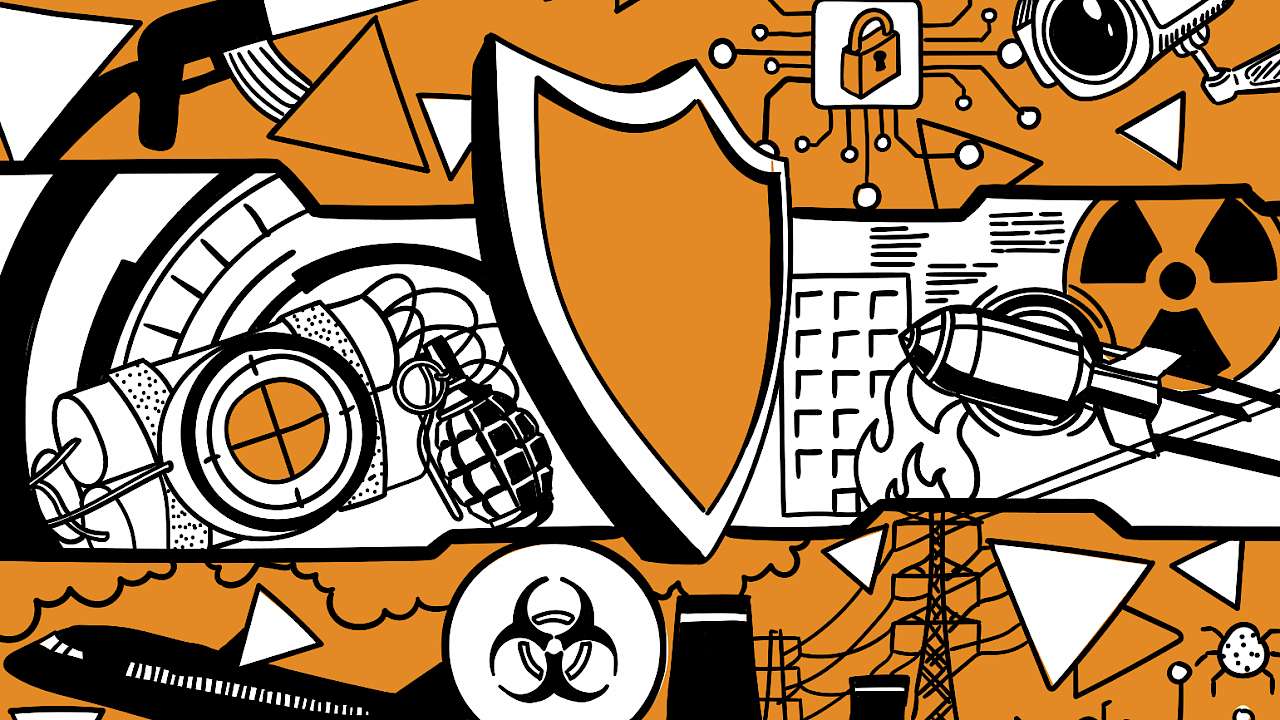Overview
This guide focuses on how the public can help to mitigate the risk of terrorism by engaging in activities relating to the Prevent and Protect workstreams of CONTEST. By considering these different elements of CONTEST, a greater understanding of counter-terrorism roles within the private sphere and performed as part of professional paid employment emerges.
The guide further highlights how public involvement in mitigating terrorism has pervaded different sectors of society, and is not limited to transportation environments or crowded areas. Barriers to public engagement in counter-terrorism roles are identified, with potential strategies for overcoming these barriers also considered.
Methodology and Strength of Evidence
This guide examines literature published between January 2017 and June 2022 and draws from work carried out in a wide range of disciplines and geographical contexts. The UK is the main focus, however evidence is derived from studies carried out in the USA, Denmark, Sweden, Norway, Finland, and Australia. The guide builds on two previous CREST reports that reviewed relevant research (Lewis & Marsden, 2021; Copeland & Marsden, 2020), and discusses 43 empirical studies.
The research focuses on a number of areas including how different categories of ‘the public’ might mitigate the risk from terrorism, and work that explores the public’s potential engagement with the Prevent and Protect workstreams of CONTEST. Prevent is concerned with stopping people becoming involved in terrorism, whilst Protect aims to strengthen the UK’s protection against a terrorist attack. These workstreams are the focus of this report as they are the areas where the public have the greatest potential role to play.
The evidence base across these areas varies. In general, there is limited empirical research quantifying public efforts to mitigate the actual risk of terrorism. Instead, research tends to study participants’ intentions in hypothetical scenarios; assesses how public communications campaigns influence behavioural intentions; and explores how these are experienced by civilians. This research predominantly uses quantitative surveys and self-report data and can be considered robust due to the large sample sizes that characterise this research..
A number of smaller-scale qualitative studies capture the reflections of practitioners who design and deliver campaigns and programmes linked to Prevent. This research provides useful insights into evaluations of training programmes captured by the experiences of end-users and/or trainers. However, because it is typically concerned with specific programmes and practitioner experiences, the findings of this research cannot necessarily be generalised.
Research examining the willingness of individuals to refer others to CVE programmes is mainly based on comparatively small samples of interview data with respondents from Muslim communities in the UK and Australia. This research provides useful, qualitative insights, however as most of these studies are focused on understanding experiences within Muslim communities, the transferability of these findings to other community contexts will benefit from further exploration.
Studies which examine the willingness of individuals to make use of more general information relating to radicalisation risk are largely based in the USA, drawing on data that is nationally representative in terms of sex, age, and ethnicity, rather than focusing on a specific demographic group. Findings from this research is more generalisable beyond the scope of the specific study but may not capture the specific experiences of particular communities.
Key Findings
- Research typically discusses four different categories of public actors:
- Members of the general public.
- Intimates (i.e., family members and friends).
- Those working in professions that receive counter-terrorism training, but who are not subject to a specific legal duty mandating them to perform a counter-terrorism role.
- Those working in professions that are subject to a relevant statutory duty.
- Each category has different roles and responsibilities and differing potential to help mitigate the risk of terrorism.
- Different categories of the public have contrasting motivations, levels of knowledge and confidence and can be subject to different kinds of biases that might shape their potential to help mitigate the risk from terrorism. These issues are helpful to keep in mind when designing training or communication initiatives.
- Access to, and level of, training varies, as does societal and/or organisational expectations of how each category of public actor should contribute to countering terrorism.
- Training and communications campaigns shape how individuals are likely to respond to a perceived threat, ranging from concern someone is at risk of radicalisation, to suspicious behaviour, or an unattended item in a public space.
- Societal and/or professional expectations and the designation of counter-terrorism functions to specific people within a community or organisational setting shape the roles they may play.
- Research examining public conceptualisations of suspected terrorist actors is limited. However, several studies explore the impact of biases based on religion and ethnicity on influencing public perception of terrorist suspects. Research has paid particular attention to the role of the media in shaping these biases.
Prevent
- ‘Intimates’ and community members are generally willing to refer individuals to the authorities under the right circumstances. However, there is a preference for exploring other localised, intra-community actions prior to contacting the authorities.
- Reporting is perceived by community respondents as an ongoing social process. Prior to formally reporting concerns to the authorities, intimates may try to intervene themselves and will often consult with wider social networks or community leaders.
- The involvement of community members has been described as ‘staging’. Staged decision-making and reporting emphasises the role of the community in responding to concerns of individual radicalisation.
- New research supports previous findings that uncertainty surrounding the outcome of reporting on the individual of concern and a lack of trust in authorities form key barriers to intimates’ reporting.
- Perceptions of CVE policy legitimacy can also influence someone’s willingness to formally report to the authorities.
Protect
- Willingness to report suspicious behaviour is partly informed by the severity of the perceived terrorist-related activity.
- Vigilant behaviour, such as reporting suspicious objects, is informed by contextual factors including the form the suspicious object takes; the availability of authority figures to report to; the location of the item (e.g., a train station; plane in flight; etc.), and the type of action that is possible given the circumstances.
- There is no guarantee that individuals will report activities that they recognise as being potentially suspicious.
- Barriers to reporting include fear of what might happen if the suspicious item is confirmed to be a security threat and a bystander effect where responsibility is deferred to others who are nearby.
- Communications targeted towards members of the public in specific professional roles and contexts can help to increase their understanding of the threat from terrorism.
- Only allocating counter-terrorism responsibilities to specific positions within an organisation can contribute to a knowledge gap amongst other staff, or disengagement from wider security practices.
- Constraints that can limit employee reporting include adherence to a ‘need-to-know’ principle which discourages employees from enquiring about broader aspects of the organisation’s work, and reticence due to a belief in a co-worker’s trustworthiness because they hold security clearance.
- Public information campaigns can improve public preparedness. Programmes which involve greater participant engagement (e.g., a drill rather than written material) can improve short-term preparedness.
- Private organisations – particularly transport companies – have the potential to play a key role in communicating appropriate responses to members of the general public.
Barriers to public engagement in counter-terrorism roles
- Whilst specific barriers vary depending on the type of counter-terrorism action being undertaken, two commonly reported constraints relate to unwillingness and uncertainty.
- The perceived legitimacy of security policies and extent to which they are carried out in line with the principles of procedural justice influence public willingness to participate in counter-terrorism.
- The potential severity of the threat shapes willingness to report. The more severe the perceived security issue, the greater the willingness to participate in counter-terrorism.
- Uncertainty appears to stem from gaps in public knowledge, such as the type of behaviour that should be reported as ‘suspicious’, or the consequences of reporting for the individual who is the subject of the report.
Recommendations
- Communication campaigns will benefit from being tailored to recognise the heterogeneity of ‘the public’ and the differing levels of motivation, confidence, and biases different groups of people might hold.
- Initiatives to encourage the public to identify and report suspicious behaviours will be supported by reducing uncertainty by providing clear information about the specific types of behaviour that should be reported, and what will happen in the aftermath of a report.
- Reporting authorities can help family, friends and community members concerned about someone at risk of radicalisation by offering transparent and sustained support including clear information about the reporting process. This can cover how to report, what to expect, and potential and actual outcomes for the individual of concern.
- Maximising opportunities to explain the reasons for counter-terrorism policies and practices to the public can help enhance their perceived legitimacy.
- Public communications campaigns are supported when delivered by trusted and credible messengers and when they can demonstrate that reports will be taken seriously.
- Organisations benefit from targeted advice and training that highlights the constraints and barriers that can act on reporting, for example, in relation to insider threats.
- Gaps in ‘regular’ workers’ knowledge of security threats could be met by making basic information accessible to staff regardless of whether their professional role includes counter-terrorism responsibilities.
- Public preparedness to respond to a Chemical, Biological, Radioactive, Nuclear or explosives incident could be enhanced through education and communication campaigns that provide knowledge and enhance confidence about what to do in an emergency.
Directions for Future Research
More research to evaluate the effects of existing public communications campaigns and the factors that have influenced actual reports have the potential to help develop more effective campaigns.
- Barriers to reporting across the full range of counter-terrorism functions remain relatively poorly understood. Additional research to understand what, when, why, and how barriers shape behaviour and what helps to overcome them would help address this knowledge gap and could inform communication and training initiatives.
- Further research on what shapes community or intimates’ willingness to report, and the circumstances under which barriers to reporting are overcome, would provide further insight into the public’s role in relation to the Prevent strand of counter-terrorism.
- More work to understand the role procedural justice and perceived legitimacy of counter-terrorism policy play in shaping public willingness to support counter-terrorism efforts could inform a range of policy and practice contexts.
- Research to better understand what shapes public perceptions of terrorist actors, and what mitigates racial or religious prejudice in relation to violent extremists could help to tailor communication campaigns or other public outreach activities to different audiences.
Read more
Aplin, D., & Rogers, M. B. (2020). ‘Alert not alarm’: The UK experience of public counter-terrorism awareness and training, with explicit reference to Project ARGUS. The Police Journal: Theory, Practice and Principles, 93(3), 167–182. https://doi.org/10.1177/0032258X19851537
Atkinson, C., Yates, D., & Brooke, N. (2020). ‘Now that you mention it, museums probably are a target’: museums, terrorism and security in the United Kingdom. Museum Management and Curatorship, 35(2), 109–124. https://doi.org/10.1080/09647775.2019.1683881
Betus, A. E., Kearns, E. M., & Lemieux, A. F. (2020). How perpetrator identity (sometimes) influences media framing attacks as “terrorism” or “mental illness”. Communication Research, 48(8), 1133-1156. https://doi.org/10.1177/0093650220971142.
Bjørgo, T., & Ravndal, J. A. (2019). Extreme-Right Violence and Terrorism: Concepts, Patterns, and Responses. Policy Brief. International Centre for Counter-Terrorism (ICCT) https://doi.org/10.19165/2019.1.08
Booth, A., Chmutina, K., & Bosher, L. (2020). Protecting crowded places: Challenges and drivers to implementing protective security measures in the built environment. Cities, 107 (May), 102891, 1-10. https://doi.org/10.1016/j.cities.2020.102891
Carson, J. V., & Politte, H. (2021). Implicit Bias Within Public Reporting: A Virtual Reality Experiment Examining “Suspicious” Activity. Crime and Delinquency, 67(12), 2135–2162. https://doi.org/10.1177/0011128720981897
Carter, H., Drury, J., & Amlôt, R. (2020). Recommendations for improving public engagement with pre-incident information materials for initial response to a chemical, biological, radiological or nuclear (CBRN) incident: A systematic review. International Journal of Disaster Risk Reduction, 51 (July), 1-12. https://doi.org/10.1016/j.ijdrr.2020.101796
Clubb, G., Kobayashi, Y., & Davies, G. (2022). Public Attitudes to Prevent and the Desistance and Disengagement Programme: Preliminary Results. Leeds: University of Leeds. Unpublished Manuscript.
Copeland, S. & Marsden, S. (2020). ‘Behavioural-Focused Protective Security Programmes: Full Report’, Knowledge Management Across the Four Counter-Terrorism ‘Ps’. Lancaster University, Lancaster: Centre for Research and Evidence on Security Threats (CREST). Available at: https://www.crestresearch.ac.uk/resources/behavioural-focused-protective-security-programmes/
Christensen, P. H. (2021). Counterterrorism protective security as part of the planning, design and development of crowded places in Australia: where are we now? Journal of European Real Estate Research, 15(1), 112-129. https://doi.org/10.1108/JERER-06-2021-0034
Dolliver, M. J., & Kearns, E. M. (2022). Is It Terrorism?: Public Perceptions, Media, and Labeling the Las Vegas Shooting. Studies in Conflict and Terrorism, 45(1), 1–19. https://doi.org/10.1080/1057610X.2019.1647673
D’Orazio, V., & Salehyan, I. (2018). Who is a Terrorist? Ethnicity, Group Affiliation, and Understandings of Political Violence. International Interactions, 44(6), 1017–1039. https://doi.org/10.1080/03050629.2018.1500911
Emerson, R. G. (2022). Vigilant Subjects, Risky Objects: "If You See Something, Say Something" Theory & Event, 25(3), 614–638. https://doi.org/10.1353/tae.2022.0030
Gøtzsche-Astrup, O., Lindekilde, L., & Fjellman, A. M. (2021). Perceived Legitimacy of CVE Policies and the Willingness to Report Concerns of Radicalization to Authorities in the Nordic Countries. Terrorism and Political Violence, 0(0), 1–17. https://doi.org/10.1080/09546553.2021.1972977
Grossman, M., Stephenson, P., & Zhang, G. (2015). Community Reporting Thresholds: Sharing Information with Authorities Concerning Violent Extremist Activity and Involvement in Foreign Conflict. Canberra: Countering Violent Extremism Subcommittee, Australia-New Zealand Counter-Terrorism Committee. https://doi.org/10.13140/RG.2.2.19345.07520.
Grossman, M. (2019). “When the ‘Right Thing to Do’ Feels so Wrong: Australian Muslim Perspectives on ‘Intimates’ Reporting to Authorities about Violent Extremism.” In J. Esposito & D. Iner (eds.) Islamophobia and Radicalization: Breeding Intolerance and Violence. London: Palgrave Macmillan, pp. 203–224. https://doi.org/10.1007/978-3-319-95237-6
Haner, M., Sloan, M. M., Pickett, J. T., & Cullen, F. T. (2021). When Do Americans “See Something, Say Something”? Experimental Evidence on the Willingness to Report Terrorist Activity. Justice Quarterly, 0(0), 1–25. https://doi.org/10.1080/07418825.2021.1942162
Havârneanu, G. M., Petersen, L., Arnold, A., Carbon, D., & Görgen, T. (2022). Preparing railway stakeholders against CBRNe threats through better cooperation with security practitioners. Applied Ergonomics, 10(2) (April), 1-11. https://doi.org/10.1016/j.apergo.2022.103752
HM Government (2018). ‘CONTEST: The United Kingdom’s Strategy for Countering Terrorism’, 4th June; updated 20th August 2018. London. Available at: https://www.gov.uk/government/publications/counter-terrorism-strategy-contest-2018
Huff, C., & Kertzer, J. D. (2018). How the Public Defines Terrorism. American Journal of Political Science, 62(1), 55–71. https://doi.org/10.1111/ajps.12329
Kaleem, A. (2022). The hegemony of Prevent: turning counter-terrorism policing into common sense. Critical Studies on Terrorism, 15(2), 267–289. https://doi.org/10.1080/17539153.2021.2013016
Kearns, E. M., Betus, A. E., & Lemieux, A. F. (2019). Why do some terrorist attacks receive more media attention than others? Justice Quarterly, 36(6), 985–1022. https://doi.org/10.1080/07418825.2018.1524507
Kumar, D. (2018). See something, say something: Security rituals, affect, and US nationalism from the cold war to the war on terror. Public Culture, 30(1), 143–171. https://doi.org/10.1215/08992363-4189203
LaFree, G., & Adamczyk, A. (2017). The Impact of the Boston Marathon Bombings on Public Willingness to Cooperate with Police. Justice Quarterly, 34(3), 459–490. https://doi.org/10.1080/07418825.2016.1181780
Lewis, J., & Marsden, S. (2020). Public Experiences of the UK Counter-Terrorism System. Full Report. Lancaster University, Lancaster: Centre for Research and Evidence on Security Threats (CREST). Available at: https://crestresearch.ac.uk/resources/public-experiences-of-the-uk-counter-terrorism-system/
Lewis, J., & Marsden, S. (2021). Countering Violent Extremism Interventions: Contemporary Research. Full Report. Lancaster University, Lancaster: Centre for Research and Evidence on Security Threats (CREST). Available at: https://crestresearch.ac.uk/resources/countering-violent-extremism-interventions/
Lewis, J., Hewitt, J., & Marsden, S. (2022). The Psychological Effects Of Criminal Justice Measures: A Review Of Evidence Related To Terrorist Offending. Centre for Research and Evidence on Security Threats (CREST). Available at: https://crestresearch.ac.uk/resources/the-psychological-effects-of-criminal-justice-measures/
Lindekilde, L., Pearce, J., Parker, D., & Rogers, B. (2021). “Run, Hide, Tell” or “Run, Hide, Fight”? The impact of diverse public guidance about marauding terrorist firearms attacks on behavioral intentions during a scenario-based experiment in the United Kingdom and Denmark. International Journal of Disaster Risk Reduction, 60 (February), 102278, 1–9. https://doi.org/10.1016/j.ijdrr.2021.102278
Madon, N. S., Murphy, K., & Cherney, A. (2017). Promoting Community Collaboration in Counterterrorism: Do Social Identities and Perceptions of Legitimacy Mediate Reactions to Procedural Justice Policing? British Journal of Criminology, 57(5), 1144–1164. https://doi.org/10.1093/bjc/azw053
McIlhatton, D., Monaghan, R., Berry, J., Cuddihy, J., Chapman, D., & Christensen, P. (2019). Protecting Commercial Real Estate and Crowded Places from Terrorism. Journal of Real Estate Literature, 27(1), 103–116. https://doi.org/10.1080/10835547.2019.12090494
McIlhatton, D., Berry, J., Chapman, D., Christensen, P. H., Cuddihy, J., Monaghan, R., & Range, D. (2020). Protecting Crowded Places from Terrorism: An Analysis of the Current Considerations and Barriers Inhibiting the Adoption of Counterterrorism Protective Security Measures. Studies in Conflict and Terrorism, 43(9), 753–774. https://doi.org/10.1080/1057610X.2018.1507311
Mitnik, Z. S., Freilich, J. D., & Chermak, S. M. (2020). Post-9/11 coverage of terrorism in the New York Times. Justice Quarterly, 37(1), 161–185. https://doi.org/10.1080/07418825.2018.1488985
Neo, L.S., Pang, J. & Chin, J. (2018). ‘Bystander intervention to prevent radicalisation’. In M. Khader, L.S. Neo, J. Tan, D.D. Cheong & J. Chin (eds.) Learning from violent extremist attacks: Behavioural sciences insights for practitioners and policymakers. Singapore: World Scientific, pp. 175– 197. https://doi.org/10.1142/11134
Parker, D., Pearce, J. M., Lindekilde, L., & Rogers, M. B. (2019). Challenges for effective counterterrorism communication: Practitioner insights and policy implications for preventing radicalization, disrupting attack planning, and mitigating terrorist attacks. Studies in Conflict and Terrorism, 42(3), 264–291. https://doi.org/10.1080/1057610X.2017.1373427
Pearce, J. M., Parker, D., Lindekilde, L., Bouhana, N., & Rogers, M. B. (2020). Encouraging public reporting of suspicious behaviour on rail networks. Policing and Society, 30(7), 835–853. https://doi.org/10.1080/10439463.2019.1607340
Rice, C., & Searle, R. H. (2022). ‘The Enabling Role of Internal Organizational Communication in Insider Threat Activity – Evidence From a High Security Organization.’ Management Communication Quarterly, 36(3), 467-495. https://doi.org/10.1177/08933189211062250
Rodrigo Jusué, I. (2021). Counter-terrorism training “at your kitchen table”: the promotion of “CT citizens” and the securitisation of everyday life in the UK. Critical Studies on Terrorism, 15(2), 290–310. https://doi.org/10.1080/17539153.2021.2013014
Rowe, M. (2018). Fostering Constructive Action by Peers and Bystanders in Organizations and Communities. Negotiation Journal, 34(2), 137–163. https://doi.org/10.1111/nejo.12221
Selod, S. (2018) Forever Suspect: Racialized Surveillance of Muslim Americans in the War on Terror. New Brunswick: Rutgers University Press. https://doi.org/10.1111/soin.12358
Shanaah, S. (2022). Alienation or Cooperation? British Muslims’ Attitudes to and Engagement in Counter-Terrorism and Counter-Extremism. Terrorism and Political Violence, 34(1), 71–92. https://doi.org/10.1080/09546553.2019.1663829
Silva, J. R., Duran, C., Freilich, J. D., & Chermak, S. M. (2020). Addressing the Myths of Terrorism in America. International Criminal Justice Review, 30(3), 302–324. https://doi.org/10.1177/1057567719833139
Sloan, M. M., Haner, M., Cullen, F. T., Graham, A., Aydin, E., Kulig, T. C., & Jonson, C. L. (2021). Using Behavioral Strategies to Cope With the Threat of Terrorism: A National-Level Study, Crime and Delinquency, 67(12), 2011-2042. https://doi.org/10.1177/0011128720940984
Tech Monitor. (2020). “NaCTSO makes online counter terrorism training course easier to access for home users”. April 7. Available at: https://techmonitor.ai/government-computing/nactso-makes-online-counter-terrorism-training-course-easier-to-access-for-home-users
Thomas, P. (2017). Changing experiences of responsibilisation and contestation within counter-terrorism policies: The British Prevent experience. Policy & Politics, 45(3), 305–321. https://doi.org/10.1332/030557317X14943145195580
Thomas, P., Grossman, M., Miah, S., and Christmann, K. (2017). Community Reporting Thresholds: Sharing information with authorities concerning violent extremist activity and involvement in foreign conflict. A UK Replication Study. Lancaster University, Lancaster: Centre for Research and Evidence on Security Threats (CREST). Available at: https://crestresearch.ac.uk/resources/community-reporting-thresholds-full-report/
Thomas, P., Grossman, M., Christmann, K., & Miah, S. (2020). Community reporting on violent extremism by “intimates”: emergent findings from international evidence. Critical Studies on Terrorism, 13(4), 638–659. https://doi.org/10.1080/17539153.2020.1791389
Williams, M. J., Bélanger, J. J., Horgan, J., & Evans, W. P. (2019). Experimental Effects of a Call-Center Disclaimer Regarding Confidentiality on Callers’ Willingness to Make Disclosures Related to Terrorism. Terrorism and Political Violence, 31(6), 1327–1341. https://doi.org/10.1080/09546553.2018.1476347
Williams, M. J., Horgan, J. G., Evans, W. P., & Bélanger, J. J. (2020). Expansion and replication of the theory of vicarious help-seeking. Behavioral Sciences of Terrorism and Political Aggression, 12(2), 89–117. https://doi.org/10.1080/19434472.2018.1546217
Williamson, H., & Murphy, K. (2022). Animus toward Muslims and its association with public support for punitive counter-terrorism policies: did the Christchurch terrorist attack mitigate this association? Journal of Experimental Criminology, 18(2), 343–363. https://doi.org/10.1007/s11292-020-09450-x
Copyright Information
As part of CREST’s commitment to open access research, this text is available under a Creative Commons BY-NC-SA 4.0 licence. Please refer to our Copyright page for full details.
IMAGE CREDITS: Copyright ©2024 R. Stevens / CREST (CC BY-SA 4.0)






